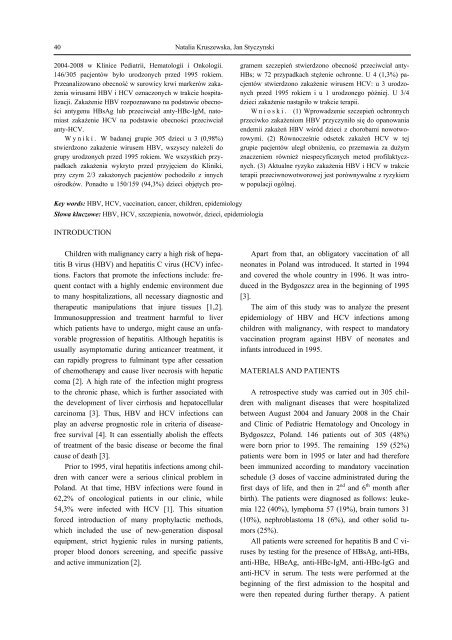medical and biological sciences - Collegium Medicum - Uniwersytet ...
medical and biological sciences - Collegium Medicum - Uniwersytet ...
medical and biological sciences - Collegium Medicum - Uniwersytet ...
You also want an ePaper? Increase the reach of your titles
YUMPU automatically turns print PDFs into web optimized ePapers that Google loves.
40Natalia Kruszewska, Jan Styczynski2004-2008 w Klinice Pediatrii, Hematologii i Onkologii.146/305 pacjentów było urodzonych przed 1995 rokiem.Przeanalizowano obecność w surowicy krwi markerów zakażeniawirusami HBV i HCV oznaczonych w trakcie hospitalizacji.Zakażenie HBV rozpoznawano na podstawie obecnościantygenu HBsAg lub przeciwciał anty-HBc-IgM, natomiastzakażenie HCV na podstawie obecności przeciwciałanty-HCV.W y n i k i . W badanej grupie 305 dzieci u 3 (0,98%)stwierdzono zakażenie wirusem HBV, wszyscy należeli dogrupy urodzonych przed 1995 rokiem. We wszystkich przypadkachzakażenia wykryto przed przyjęciem do Kliniki,przy czym 2/3 zakażonych pacjentów pochodziło z innychośrodków. Ponadto u 150/159 (94,3%) dzieci objętych programemszczepień stwierdzono obecność przeciwciał anty-HBs; w 72 przypadkach stężenie ochronne. U 4 (1,3%) pacjentówstwierdzono zakażenie wirusem HCV: u 3 urodzonychprzed 1995 rokiem i u 1 urodzonego później. U 3/4dzieci zakażenie nastąpiło w trakcie terapii.Wnioski. (1) Wprowadzenie szczepień ochronnychprzeciwko zakażeniom HBV przyczyniło się do opanowaniaendemii zakażeń HBV wśród dzieci z chorobami nowotworowymi.(2) Równocześnie odsetek zakażeń HCV w tejgrupie pacjentów uległ obniżeniu, co przemawia za dużymznaczeniem również niespecyficznych metod profilaktycznych.(3) Aktualne ryzyko zakażenia HBV i HCV w trakcieterapii przeciwnowotworowej jest porównywalne z ryzykiemw populacji ogólnej.Key words: HBV, HCV, vaccination, cancer, children, epidemiologySłowa kluczowe: HBV, HCV, szczepienia, nowotwór, dzieci, epidemiologiaINTRODUCTIONChildren with malignancy carry a high risk of hepatitisB virus (HBV) <strong>and</strong> hepatitis C virus (HCV) infections.Factors that promote the infections include: frequentcontact with a highly endemic environment dueto many hospitalizations, all necessary diagnostic <strong>and</strong>therapeutic manipulations that injure tissues [1,2].Immunosuppression <strong>and</strong> treatment harmful to liverwhich patients have to undergo, might cause an unfavorableprogression of hepatitis. Although hepatitis isusually asymptomatic during anticancer treatment, itcan rapidly progress to fulminant type after cessationof chemotherapy <strong>and</strong> cause liver necrosis with hepaticcoma [2]. A high rate of the infection might progressto the chronic phase, which is further associated withthe development of liver cirrhosis <strong>and</strong> hepatocellularcarcinoma [3]. Thus, HBV <strong>and</strong> HCV infections canplay an adverse prognostic role in criteria of diseasefreesurvival [4]. It can essentially abolish the effectsof treatment of the basic disease or become the finalcause of death [3].Prior to 1995, viral hepatitis infections among childrenwith cancer were a serious clinical problem inPol<strong>and</strong>. At that time, HBV infections were found in62,2% of oncological patients in our clinic, while54,3% were infected with HCV [1]. This situationforced introduction of many prophylactic methods,which included the use of new-generation disposalequipment, strict hygienic rules in nursing patients,proper blood donors screening, <strong>and</strong> specific passive<strong>and</strong> active immunization [2].Apart from that, an obligatory vaccination of allneonates in Pol<strong>and</strong> was introduced. It started in 1994<strong>and</strong> covered the whole country in 1996. It was introducedin the Bydgoszcz area in the beginning of 1995[3].The aim of this study was to analyze the presentepidemiology of HBV <strong>and</strong> HCV infections amongchildren with malignancy, with respect to m<strong>and</strong>atoryvaccination program against HBV of neonates <strong>and</strong>infants introduced in 1995.MATERIALS AND PATIENTSA retrospective study was carried out in 305 childrenwith malignant diseases that were hospitalizedbetween August 2004 <strong>and</strong> January 2008 in the Chair<strong>and</strong> Clinic of Pediatric Hematology <strong>and</strong> Oncology inBydgoszcz, Pol<strong>and</strong>. 146 patients out of 305 (48%)were born prior to 1995. The remaining 159 (52%)patients were born in 1995 or later <strong>and</strong> had thereforebeen immunized according to m<strong>and</strong>atory vaccinationschedule (3 doses of vaccine administrated during thefirst days of life, <strong>and</strong> then in 2 nd <strong>and</strong> 6 th month afterbirth). The patients were diagnosed as follows: leukemia122 (40%), lymphoma 57 (19%), brain tumors 31(10%), nephroblastoma 18 (6%), <strong>and</strong> other solid tumors(25%).All patients were screened for hepatitis B <strong>and</strong> C virusesby testing for the presence of HBsAg, anti-HBs,anti-HBe, HBeAg, anti-HBc-IgM, anti-HBc-IgG <strong>and</strong>anti-HCV in serum. The tests were performed at thebeginning of the first admission to the hospital <strong>and</strong>were then repeated during further therapy. A patient
















